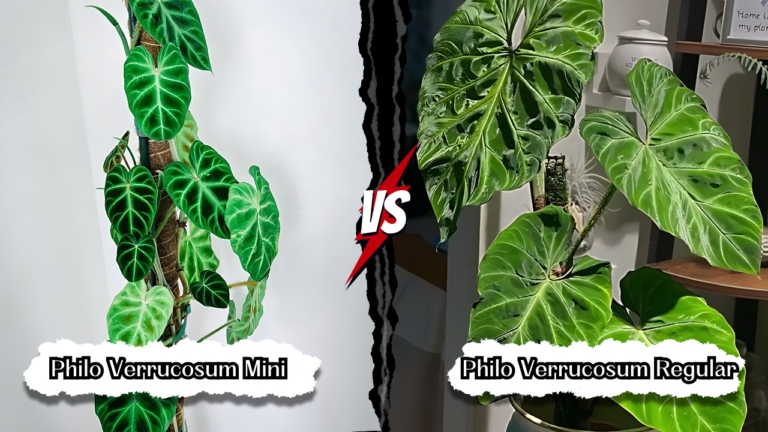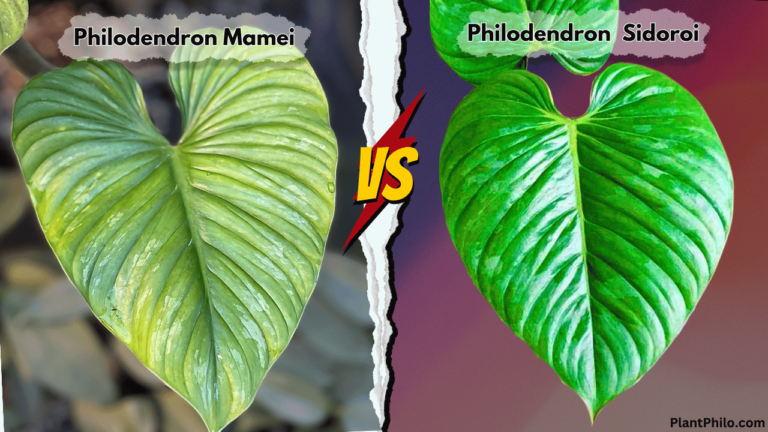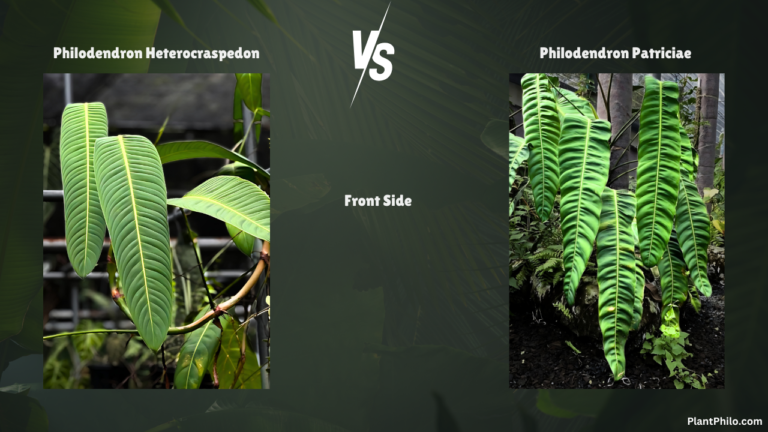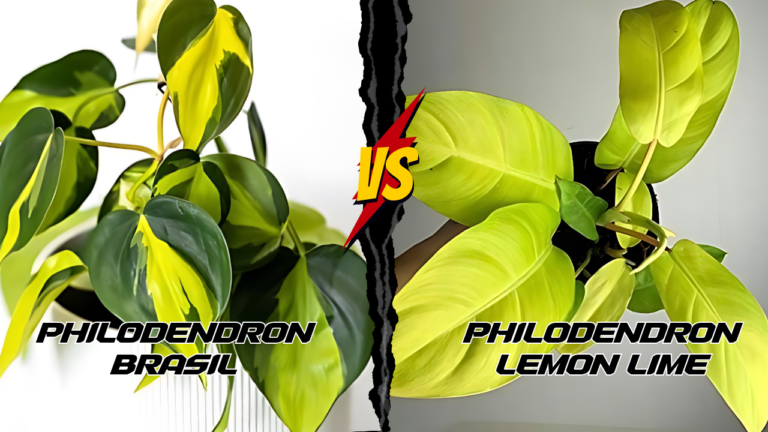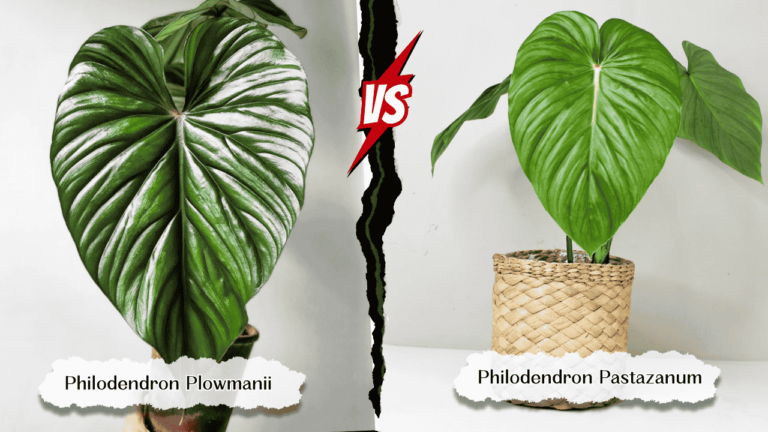Philodendron Burgundy Princess Vs Pink Princess: Is Yours Really a Burgundy Princess?
Think you have a Pink Princess, but she’s looking a little…well, not-so-pink? Don’t despair! There’s a whole other Philodendron royalty out there called the Burgundy Princess, and she might just be your plant’s true identity. Let’s play detective and get to the root of this leafy mystery.
Deciding between the Philodendron Burgundy Princess and Pink Princess can be quite a challenge, especially for plant enthusiasts who appreciate unique foliage. These two varieties of philodendrons boast striking colors and patterns that can brighten any indoor space. But how do you know which one suits you best?
The Philodendron Pink Princess is famous for its dark green leaves splashed with vibrant pink, making each plant a unique work of art. Meanwhile, the Philodendron Burgundy Princess offers a more subtle charm with deep reddish leaves that can appear almost burgundy.
Understanding the unique care and growth requirements of each plant can empower you to make the perfect addition to your home. Whether you’re drawn to a specific color pattern or considering maintenance needs, our comprehensive guide will equip you with all the necessary knowledge to make an informed decision.
Key Takeaways
- Burgundy Princess has dark reddish leaves; Pink Princess features pink variegation.
- Both plants thrive with similar care requirements but offer different visual appeal.
- Encouraging variegation in Pink Princesses can enhance their unique appearance.
Comparison Summary at A Glance
| Feature | Philodendron Pink Princess | Philodendron Burgundy Princess |
| Origins | Natural Hybrid | Cultivar of Pink Princess |
| Defining Characteristic | Pink variegation | Burgundy/purple tones, less or no pink |
| Leaf Shape | Heart-shaped | Heart-shaped |
| Leaf Size | 6-12 inches | 6-12 inches |
| Leaf Texture | Smooth, slightly glossy | Smooth, slightly glossy |
| New Leaf Color | More pink variegation | Burgundy/green, darkens with age |
| Petiole (Leaf Stalk) | Green with reddish/purple hues | Green with reddish/purple hues |
| Variegation | Pink (speckled, sectorial, or marbled) | Darker variegation, not pink |
| Light Requirements | Brighter indirect light | Tolerates lower light levels |
| Growth Habit | Vining | Vining |
| Growth Rate | Moderate to fast | Moderate to fast |
| Rarity/Price | More rare, expensive | More common, less expensive |
Additional Notes:
- Variegation: The key difference lies in the variegation. Pink Princesses exhibit various amounts of pink variegation, while Burgundy Princesses primarily showcase burgundy or purple tones, even on completely green leaves.
- Light: Pink Princesses require brighter light to maintain their pink variegation, while Burgundy Princesses are more tolerant of lower light conditions.
- Care: Overall care requirements are similar for both plants, but Pink Princesses with high variegation might be slightly more sensitive.
- Propagation: Both can be propagated through stem cuttings, but ensure the cutting from a Pink Princess includes a node with pink variegation to maintain the trait.
Background and Origins
Both the Philodendron Pink Princess and Philodendron Burgundy Princess are popular for their unique and striking foliage. Differences in leaf color and variegation make them stand out.
Philodendron Pink Princess
The Philodendron Pink Princess (PPP) is a cultivar of the species Philodendron erubescens. It’s highly sought after by collectors for its vibrant and colorful appearance, which can make it a bit more expensive and harder to find. However, with a little patience and perseverance, you can add this unique beauty to your collection.
The Pink Princess originates from South America, specifically from the tropical rainforests. It thrives in warm, humid conditions. To encourage its pink variegation, make sure it gets plenty of bright, indirect light. Avoiding direct sunlight is crucial as it can burn the leaves. Consistent humidity and careful watering also play a big role in maintaining the vibrant pink coloring.
Philodendron Burgundy Princess
The Philodendron Burgundy Princess is another beautiful variant of the Philodendron erubescens. It has dark green leaves with a burgundy tint, which sets it apart from its pink counterpart. The variegation in Burgundy Princess is usually less pronounced than in the Pink Princess, resulting in more uniformly colored foliage with subtle shading.
Originally from the same South American regions as the Pink Princess, the Burgundy Princess also flourishes in warm and humid environments. It prefers temperatures between 65-80°F (18-27°C) and high humidity levels. While it might not need as much light as the Pink Princess to show off its colors, ensuring it gets adequate indirect light will keep it healthy and lush.
Whether you prefer the pink splashes on the Pink Princess or the deep, rich tones of the Burgundy Princess, both plants bring a unique aesthetic to any space.
Visual Comparison: Leaves
When comparing the Philodendron Burgundy Princess and Pink Princess, several differences become evident. The distinctions in leaf shape, size, texture, color, new leaf color, and petioles are noteworthy for any plant enthusiast or collector.
Shape
The leaves of the Pink Princess are often more elongated with an oval shape. You’ll notice a slightly pointed tip which adds to their elegant appearance.
In contrast, Burgundy Princess leaves are broader and have a more heart-like shape. This distinction is subtle but noticeable once you become familiar with both plants. The overall shape is crucial in differentiating them at first glance.
Size
In terms of size, both plants have leaves that can grow quite large, but the Burgundy Princess tends to have slightly bigger leaves.
The Pink Princess’s leaves usually range between 6-8 inches in length when fully grown. The Burgundy Princess can have leaves that reach up to 10 inches or more. This size variation can be influenced by growing conditions and care practices.
Texture
Texture is another key difference. Pink Princess Philodendron leaves are usually smooth and glossy. This smooth texture adds to their beauty, especially when the light catches the surface, enhancing the pink and green variegation.
Burgundy Princess leaves have a more matte finish. While still smooth, they lack the high gloss of their Pink Princess counterparts. This gives them a slightly different visual appeal, adding a touch of sophistication to their foliage.
Color
The Pink Princess captivates with its lush green leaves adorned with pink variegation, the intensity of which can range from delicate pastels to vivid pinks. This vibrant display is a hallmark of this variety.
On the other hand, the Burgundy Princess has deep burgundy leaves that can sometimes appear almost black. This dramatic color difference is the primary reason these two plants are often compared.
New Leaf Color
When new leaves emerge, the Pink Princess often surprises with more pink than the mature leaves. You’ll find that new leaves start with a brighter, more intense pink before they eventually darken and mix with green.
New leaves of the Burgundy Princess are lighter but still possess that deep burgundy hue that darkens as they age. This gradual shift in color from new to mature leaves is another fascinating aspect of these plants.
Petioles (Leaf Stalks)
The petioles of the Pink Princess are slender and usually have a pinkish tint, complementing the pink variegation on the leaves. This subtle detail adds to the plant’s overall aesthetic.
Burgundy Princess petioles are sturdier and typically dark burgundy in color, matching the rich tone of the leaves. This robust structure supports the larger leaves and adds to the plant’s striking appearance.
Variegation Deep Dive
Variegation in Philodendron leaves is highly prized, especially in varieties like the Burgundy Princess and Pink Princess. Understanding how variegation works can help you care for these unique plants better.
Types of Variegation
Philodendron Burgundy Princess and Pink Princess boast different types of variegation. The Pink Princess has heart-shaped leaves with pink splashes. These pink areas lack chlorophyll but make the plant a real showstopper.
In contrast, the Burgundy Princess mostly features dark green leaves with occasional spots of burgundy. Variegation in these plants often appears in a mix of patterned and non-patterned leaves.
Knowing these types of variegation helps you understand the care needs, as more variegated leaves may need more light.
Instability of Variegation
Variegation in these philodendrons can be unstable. The Pink Princess, in particular, may revert to greener leaves over time. This is due to the plant’s genetic makeup, which can cause pink leaves to diminish.
To maintain the pink variegation, make sure your plant receives bright, indirect light. Too little light can lead to more green leaves. Pruning back stems that lose variegation can also help keep the pink patterns.
Burgundy Princess variegation is generally more stable, but proper light and care are still essential for keeping those unique burgundy spots.
Rarity and Value
Both the Burgundy Princess and Pink Princess are rare and can be expensive. The rarity of the Pink Princess, with its striking variegated leaves, often makes it a sought-after plant in collections. Each plant’s unique variegation pattern adds to its value.
Burgundy Princess plants are also rare but usually less expensive than Pink Princesses. This is because their burgundy variegation is less pronounced. Both types, however, can fetch high prices based on their variegation quality.
Collecting these plants is like an investment. Proper care and optimal light conditions help maintain their value. For Pink Princesses, encouraging variegation through good light and careful pruning can preserve their rare, expensive appearance.
Growth Habit and Structure
Philodendron Burgundy Princess and Pink Princess have a vining growth habit. These plants can benefit from a support structure like a moss pole or a trellis. When provided with a structure, they can climb and grow more effectively, producing healthier foliage.
Growth Rate
- Both plants have a moderate to fast growth rate.
- The Pink Princess may grow slightly slower if it has high variegation.
Encouraging Variegation in Pink Princess
For the Pink Princess, maximizing variegation can be achieved by providing bright, indirect light. This helps maintain the pink hues in the leaves. Be mindful that high variegation can slightly slow down the growth rate.
Care Requirements
Both the Philodendron Burgundy Princess and Pink Princess have similar care needs with specific requirements for light, water, humidity, temperature, soil, pH levels, and fertilizer. Additionally, to maintain the pink variegation in the Pink Princess, you will need to follow some specific guidelines.
Light
Philodendrons thrive in bright, indirect light. While the Pink Princess needs more light to maintain its variegation, the Burgundy Princess can handle slightly lower light levels.
- Pink Princess: Place it near a window with filtered light. Too much direct sunlight can scorch the leaves. If the pink variegation starts to fade, gradually increase the light exposure.
- Burgundy Princess: It does well in partial shade but benefits from bright, indirect light.
Water
Proper watering is crucial for the health of both types of Philodendrons. Overwatering can lead to root rot.
- Pink Princess: Water when the top inch of soil feels dry. It’s better to underwater than to overwater.
- Burgundy Princess: Water it once a week, ensuring the top inch of soil is dry before watering again. Always use room-temperature water.
Humidity
Both plants prefer high humidity levels. If your home has dry air, you may need to take extra steps to increase the humidity.
- Pink Princess: Aim for a room humidity level of 60% or higher. You can use a humidifier or a pebble tray with water to maintain humidity.
- Burgundy Princess: Similar to the Pink Princess, it thrives in high humidity. Misting the leaves occasionally can help.
Temperature
Maintaining the right temperature is key for the health of your Philodendrons.
- Pink Princess: Ideal temperatures are between 65-80°F (18-27°C). Avoid temperatures below 55°F (13°C).
- Burgundy Princess: It also prefers 65-80°F (18-27°C) and can tolerate slightly cooler temperatures but should be kept above 55°F (13°C).
Soil
Well-draining soil is necessary to prevent waterlogging.
- Pink Princess: Use a mix of potting soil, perlite, and orchid bark. This ensures good drainage and aeration.
- Burgundy Princess: A similar soil mix works best with potting soil, perlite, and some peat moss for moisture retention.
pH Level
Maintaining the correct pH level in the soil ensures nutrient availability.
- Pink Princess: Prefers slightly acidic soil with a pH level between 5.5 and 6.5.
- Burgundy Princess: Similar pH requirements, aiming for a range of 5.5 to 6.5 to keep the plant healthy.
Fertilizer
Regular feeding is important for these Philodendrons, especially during the growing season.
- Pink Princess: Use a balanced, water-soluble fertilizer every 4-6 weeks in spring and summer. Reduce feeding in fall and winter.
- Burgundy Princess: Fertilize every 4-6 weeks with a balanced formula. Be cautious not to over-fertilize to avoid salt build-up in the soil.
Support
As these plants grow, they might need support to maintain their form.
- Pink Princess: Use a moss pole or a stake to support the stems. This helps it grow upright and showcase its beautiful leaves.
- Burgundy Princess: Similar support structures like a moss pole or trellis can be used to help it grow and spread appropriately.
Propagation
Propagating Philodendron plants, including the Burgundy Princess and Pink Princess, can be a rewarding experience. Both these plants can be propagated through stem cuttings, making it easy to increase your collection.
Step-by-Step Propagation Process:
- Select a Healthy Cutting: Choose a healthy stem with at least one or two nodes. Nodes are small bumps where leaves grow from the stem.
- Make the Cut: Use clean, sharp scissors to cut just below a node.
- Remove Lower Leaves: Remove any leaves near the bottom of your cutting.
- Place in Water or Soil: You can place the cutting in water until roots develop or plant it directly in the soil.
Variegation Considerations
For Philodendron Pink Princess, it’s important to select cuttings that include nodes with pink variegation. This helps maintain the beautiful pink coloration during new growth.
Philodendron Burgundy Princess may also produce variegated leaves, but this trait could be more predictable.
Encouraging Bushier Growth
Proper care during the growing season can encourage bushier and healthier plants. Regularly trim any dead or damaged leaves and consider occasional pruning to promote more branches.
Tips:
- Use a container with a clear lid for added humidity.
- A mixture of perlite and potting soil can improve drainage and aeration.
- For Pink Princess, increasing humidity with a humidifier or a plastic bag over the cutting may help.
Additional Considerations
Price: Keep in mind that the Pink Princess Philodendron with high variegation can be quite expensive. The Burgundy Princess tends to be more affordable because it’s produced at higher rates.
Availability: The Burgundy Princess is easier to locate. It’s more common in nurseries and online shops. On the other hand, the Pink Princess, especially the ones with striking pink variegation, can be harder to find.
Care: Both plants thrive in indirect light and need similar care routines. Ensure you’re watering them properly to avoid root rot. They both enjoy high humidity levels.
Problems: Keep an eye out for pests like mealybugs and spider mites. Regularly check the leaves and stems. If you spot any pests, treat them immediately with insecticidal soap or neem oil.
Potting Soil: Use well-draining soil for both types. A mix of peat, perlite, and orchid bark works well. This helps in preventing waterlogging, which can lead to root problems.
Repotting: Repotting should be done every 2-3 years. Look for signs like roots growing out of the drainage holes or the soil drying out too quickly.
Encouraging Variegation: For Pink Princess, maintain bright indirect light to encourage variegation. Avoid placing them in low light conditions as this can reduce the pink variegation on their leaves.
Choosing the Right Plant for You
When deciding between the Philodendron Burgundy Princess and the Pink Princess, consider your preferences and needs. Both plants have unique qualities that make one more appealing to you.
Aesthetics
The Pink Princess is famous for its striking pink variegation, adding a splash of vibrant color to your indoor space. If you love bright, eye-catching hues, this might be your pick.
On the other hand, the Burgundy Princess boasts deep, rich burgundy leaves. This plant adds a touch of sophistication with its darker, moody tones, perfect for a more subtle yet elegant look.
Budget
Your budget can also influence your decision. The Pink Princess is often more expensive due to its popularity and unique coloring. It’s a prized plant that might cost more upfront.
The Burgundy Princess is generally more budget-friendly, making it an excellent choice if you’re looking for beauty without breaking the bank.
Care Confidence
Consider how much time and effort you can dedicate to plant care. The Burgundy Princess is easier to maintain and may be more suitable for beginners or those with a busy schedule.
The Pink Princess may require more attention, especially if you want to enhance its variegation. Ensure it gets bright, indirect light, and try rotating the plant to encourage variegation.
Planting and Buying
Both plants thrive indoors, making them great for your home. They enjoy bright, indirect light and need regular watering, but the soil should be fine. You can find both plants online or at local plant stores.
Color
If you love vibrant and unique colors, the Pink Princess, with its pink hues, is a fantastic choice. For those who prefer richer and darker foliage, the Burgundy Princess stands out with its deep, burgundy leaves.
Frequently Asked Questions
Caring for Philodendron Burgundy Princess and Pink Princess plants involves understanding their lighting, temperature, and humidity needs. Recognize specific issues like leaves changing color and how to confirm the identity of your plant.
How do I care for a Philodendron Burgundy Princess?
The Philodendron Burgundy Princess prefers temperatures between 65-80°F (18-27°C). Keep it in bright, indirect light and maintain high humidity levels. Avoid temperatures below 55°F (13°C) to prevent leaf damage. Water the plant when the top inch of soil feels dry.
What are the distinct care requirements for a Philodendron Pink Princess?
The Pink Princess Philodendron thrives with bright indirect light from an east or west-facing window. It needs temperatures between 60-85°F (16-27°C) and humidity levels around 60-80%. Ensure the soil is kept slightly moist but not waterlogged.
Why are the leaves on my Pink Princess turning burgundy?
Your Pink Princess leaves may turn burgundy due to changes in light, temperature, or nutrient availability. Maintaining consistent care and optimal conditions can help keep the variegation stable.
Can a Reverted Pink Princess revert back to having more pink variegation?
Yes, a reverted Pink Princess can sometimes regain its pink variegation. Increase light exposure and prune the green leaves. New growth might show more pink as a result.
How does the Philodendron Royal Queen differ from the Burgundy Princess and Pink Princess?
The Philodendron Royal Queen typically has darker foliage compared to the Burgundy Princess and Pink Princess. The leaves of the Royal Queen are usually glossy and deep green, while the Pink Princess sports pink variegation and the Burgundy Princess displays burgundy hues.
What should I look for to confirm that my plant is indeed a Pink Princess Philodendron?
To confirm a Pink Princess Philodendron, check for characteristic pink variegation on the leaves. The leaves should have a mix of green and pink shades. The size and shape of the leaves can also help identify it, as a healthy Pink Princess will have medium-sized leaves reaching up to 8 inches long.

